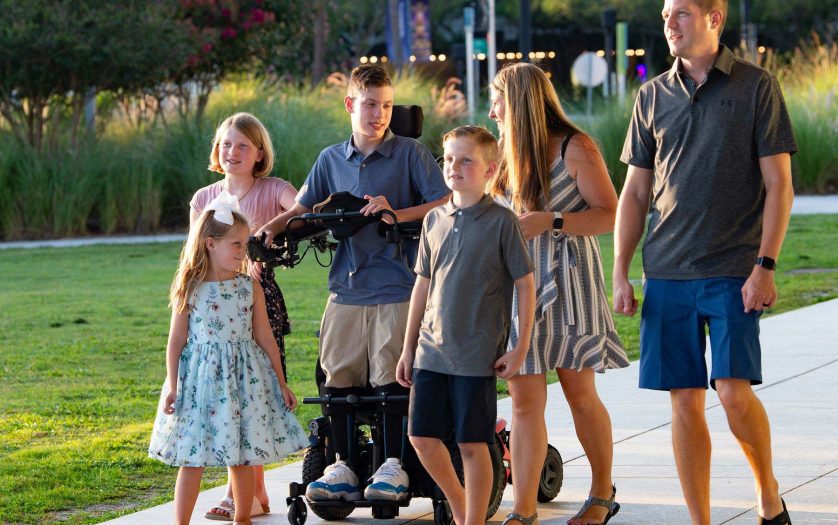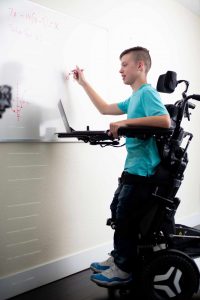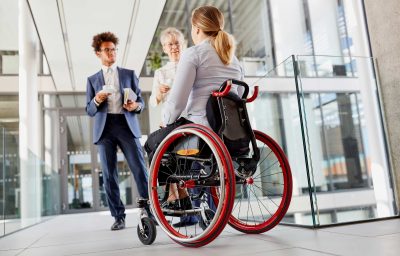
Permobil, a company dedicated to providing advanced healthcare solutions, feels strongly that every wheelchair user should have access to standing wheelchairs.
With over 44 years of experience designing and manufacturing standing power wheelchairs, Permobil has recently published a new paper researching the clinical, functional, and psychosocial benefits of power standing for both children and adults.
“We are pleased to share the results of this comprehensive review with the industry,” said Chuck Witkowski, president of Permobil Americas. “As the originator of the standing power wheelchair, Permobil has been the leading innovator of this technology to therapists, ATPs, and end users for over four decades. This research clearly summarizes how standing functionality positively impacts the everyday life of our end users.”
 Power standing is defined as a system that encompasses the ability for a standing system (consistent of multiple actuators and power seat functions such as tilt, recline, elevating legs, and seat elevate) to be utilized in its full capacity upon a power wheelchair base. This combination of seat functions and power base allow the user to optimally achieve both a seated and standing position within the system.
Power standing is defined as a system that encompasses the ability for a standing system (consistent of multiple actuators and power seat functions such as tilt, recline, elevating legs, and seat elevate) to be utilized in its full capacity upon a power wheelchair base. This combination of seat functions and power base allow the user to optimally achieve both a seated and standing position within the system.
The health risks of prolonged sitting are widely acknowledged. In the most recent guidelines, people with mobility disabilities are recommended to limit the amount of time spent sitting or lying down.
The in-depth report investigated why users should have access to a power standing wheelchair to not only minimize the health risks of sitting, but to improve their overall health, performance of activities of daily living, social interactions, and mental well-being.
The design of living and workspaces in the Western world is typically based on the assumption a person can stand, for example, kitchen counters and cooking surfaces, bathroom sinks, cupboards, handles, and light switches. Since the default position of wheelchair users is to sit, this consequently means that average living and work spaces are inaccessible. Power standing allows a person to access a wider range of unmodified spaces. Besides independent activities of daily living (ADLs), functional benefits also include communication and education.
The user can perform a variety of activities while standing, thereby combining functional with clinical and psychosocial benefits. Power standing can be performed both indoors and outdoors, and can aid productivity and integration at work, school, and church. It can also enhance independence, for example, enabling one to go shopping alone. Being able to power stand from one’s wheelchair also decreases transfers, thereby enhancing safety, conserving energy, and reducing dependency.
Furthermore, power standing wheelchair users can benefit in a variety of (unmodified) community settings to enhance their independence, improve vocational requirements, and enable recreational activities. Such situations include the ability to access vending machines, high elevator buttons and coffee shop counters; standing up to access drawers and other necessities at work, enabling users to do jobs which need to be performed from a standing position, and standing up with others for a ball game.
For adolescents standing in a power wheelchair, everyday tasks, such as cooking, could be performed without asking for assistance. Furthermore, personal care routines were generally faster and required less use of hoists and transfers. After the introduction of a power standing wheelchair, parents also noted a decreased demand of their care, and teachers more time to focus on teaching.
Performing in a play, singing in a choir, playing with friends, working at a grocery store, partaking in chemistry lab, doing chores at home and in the yard, and eating at restaurants with high-top tables were all mentioned as situations where children’s participation could benefit from power standing.
Fourteen year old Landon, who lives with cerebral palsy, used a walker for his standing protocol; however, he wasn’t able to stand for long periods of time. Now with the standing power wheelchair, Landon said, “I can stand independently, I don’t have to wait for people…”
“I think this was very important because it has increased my independence and my self esteem,” he added.
To learn more about Landon’s journey to standing, go to https://hub.permobil.com/the-journey-to-standing
The top takeaways from Permobil’s research included:
- the positive effects on pressure relief for skin, bone mineral density, and bowel/bladder function in users
- individuals benefit from improved mental health, self-esteem, and the increased ability to communicate and perform daily activities
- children are enabled to better participate in social and educational activities, as were adults in both work and community settings
To read the paper in it’s entirety, go to https://hub.permobil.com/white-paper-power-standing








